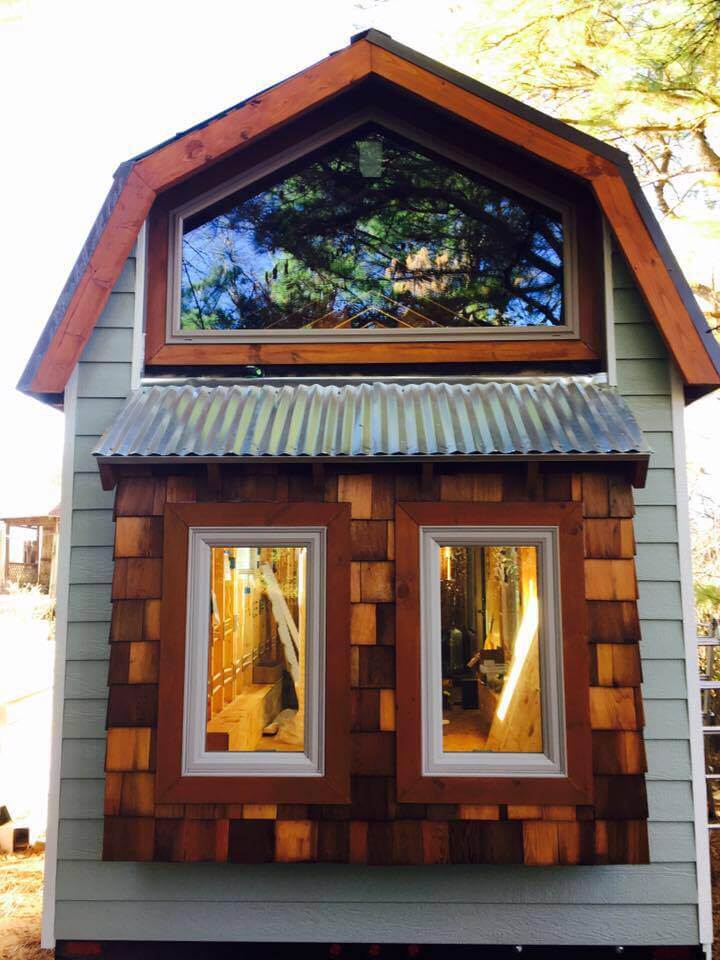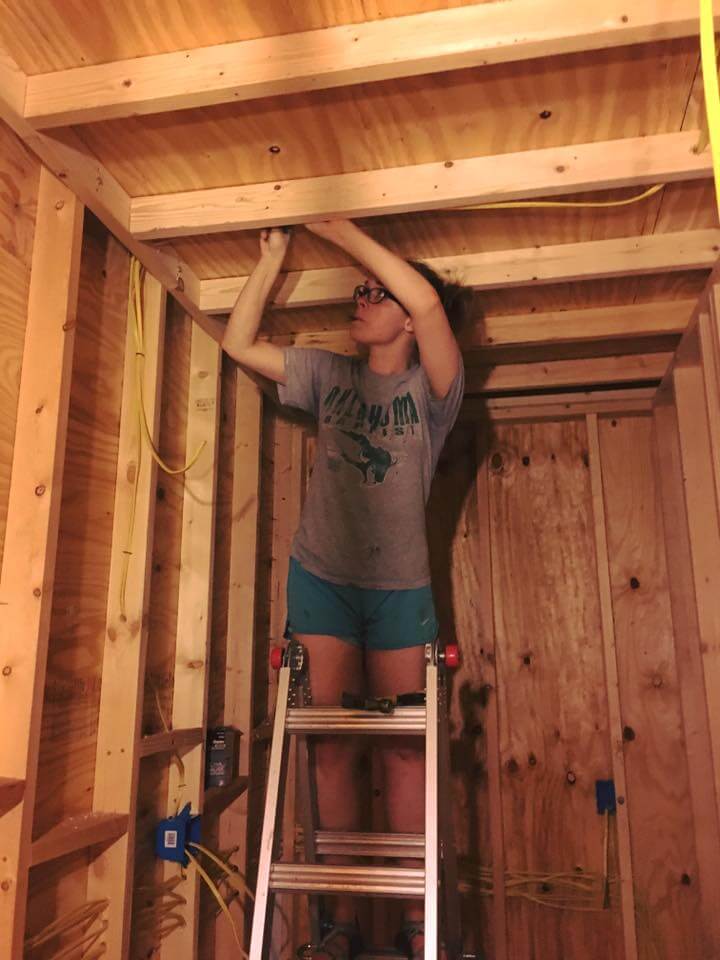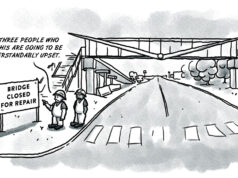
Britni and Justin Portrey want what most 20-somethings want: a place to call home. When they entered the housing market, however, they quickly learned a mortgage was not an option, but renting was no longer ideal, either.
“We were living in Stillwater and spending over $1,000 a month on rent,” said Britni, 24. “We knew we didn’t want to keep doing this long-term, but we weren’t able to get approval for a mortgage.”
Left with limited options, the two decided to do something a little out of the ordinary: They began building a tiny home.
“It was my mom who actually suggested building a tiny home,” said Britni. “At first, I thought it was a crazy idea because I couldn’t fit everything into 300 square feet, but we thought about it, thought about what was most important to us and we just did it.”
Minimalism, debt removal drive project

While a big part of the tiny house movement is minimalism – or a reduction in the amount of things owned – financial freedom and reducing debt constitute other important aspects. Britni and Justin, 25, want to eliminate their student loans and other debts while they live in their tiny house, but they wouldn’t be able to achieve their goals unless they built it without taking on additional loans.
“We have 13 windows in our tiny home, and we would buy two at a time,” said Britni. “Things like that made it feel like we were always making progress.”
They also used a lot of hand-me-downs and recycled items to make the home more affordable.
“Justin and I just didn’t fully realize what went into building a tiny house,” said Britni. “We realized really quickly that it takes a really long time when you are buying all the products on your own without getting a loan.”
Hurdle after hurdle

Constructing their first tiny home brought on a slew of new challenges to conquer, from learning how to communicate with each other to how to properly install a front door.
The couple’s first hurdle was finding a place to build the home. Members of their family agreed to let them complete the construction on their property. The second hurdle was buying the right trailer with enough support for the structure. The couple began researching to find the right trailer to support the home structure, and trailer-based construction brought its own set of challenges, too.
“When you’re building on a trailer, as opposed to building on a concrete slab, when you are walking and building on it, you have to go back and constantly re-level,” said Portrey. “I see the pictures online, on Pinterest, and they are perfectly staged, then I look at my home and see a crack there and a smudge here, or this isn’t perfectly level. There was this picture-perfect home in my head that was finished and ready, and if I would get too hung up on that, I would feel like this whole thing is a failure because I see every single failure and every single struggle of our house because I built my house.”
“It was kind of a trial-and-error process for us for at least the first six months before we knew what would work,” said Justin. “If we could just get one thing done a day, big or small, then I knew we would get through it.”
On long days, the couple learned a lot about each other, and they pushed each other to move forward despite the struggles.
“This tiny house build is God’s form of marriage counseling,” she said. “Any argument you can think of regarding building a house, we’ve had it. Both of our futures are invested in this house, and we don’t have time to do the passive-aggressive thing and not get down to what was really bothering us. We learned to get down to the core of what we were arguing about to get through it.”

(Kristy Sturgill)
Now comes the hard part
When the Portreys had finished most of the construction, they thought the hardest part of the journey was behind them, but they had yet to face the highest hurdle: Oklahoma City’s zoning ordinances.
The legal question of, “What is a tiny home?” has been puzzling city leaders and slowing the couple from moving their tiny house onto a property they bought within OKC’s city limits. Because their home lacks a permanent foundation, it isn’t just a “small house.” It also doesn’t undergo the same inspection requirements as an RV, so it can’t be classified as that, either. As a result, neither residential-zoned nor RV-approved land would legally suit the placement of the Portrey’s tiny home on wheels.
For those reasons, the Portreys have been working with the City of OKC to develop a plan for how tiny living will fit into OKC’s ordinance landscape. As a more affordable living option, the movement has appeal for single parents or young couples. Further, in larger metropolitan areas like Dallas and Detroit, tiny living spaces have helped curb homelessness.
“Right now, none of our building codes allow for tiny homes, and some of our zoning doesn’t either. It is going to take awhile for us to change our building codes,” said Kristy Yager, director of public relations for Oklahoma City. “It could take years.”
Yager said there are many details in building codes and changing them is complicated. She said the city is not against the tiny house movement and wants to find the best way to incorporate tiny homes.
“It’s not just Oklahoma City having to evaluate tiny homes, it is all across the nation,” she said.
Ahead of a Sept. 28 meeting with the Planning Commission, the Portreys urged residents to write letters of support to their council members and state representatives. The couple also started a fundraising effort to cover the legal costs and other fees associated with applying for rezoning through the city.
Ultimately, that meeting was canceled, but this was actually a positive development in the Portey’s tiny home quest. As Britni wrote Sept. 26 in a post on the couple’s Tiny Is Now blog:
Though we would have made some progress towards our city becoming more tiny home on wheels friendly had the Planning Commission passed our application, the ordinance would have been unfortunately limited to our 2 acres. Any other family wanting to live tiny and on wheels on their property would have had to go through exactly the same strenuous process we went through. … Various members of the Zoning and Code Departments as well as the Planning Commission have expressed their concern that going down this avenue does not adequately solve the issue of the city’s current ordinances keeping it from being legal to live in a THOW in OKC on residential property. And, gosh darn it, they want to find a better solution … !
While Britni said the City looks forward to working with them, officials mentioned needing to know the interest citywide to confirm that the lifestyle is truly a trend before passing new ordinances to govern the new living arrangements.
Much more than just a house
The Portreys didn’t intend to become a driving voice for the tiny house movement in Oklahoma City, but their determination to stay in OKC in a house they want to call home inspired them to find solutions. Further, the legality of the couple’s home has far-reaching implications once the fledgling family seeks to expand.
“For us, it is how do we live out tiny lifestyle legally, because ultimately, we want to adopt,” said Britni. “Adoption is expensive, and our house will give us a chance to adopt a child.”






















